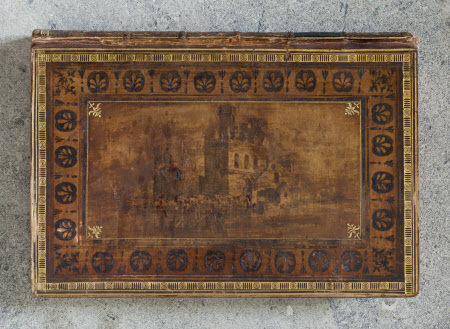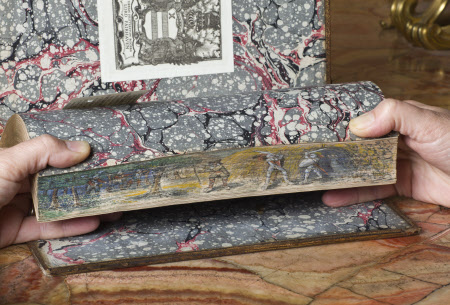The castle of Otranto, : a gothic story. / Translated by William Marshal, gent. from the original Italian of Onuphrio Muralto, ...
Horatio Walpole, 4th Earl of Orford (1717 - 1797)
Category
Books
Date
1791
Materials
Place of origin
Parma
Order this imageCollection
Anglesey Abbey, Cambridgeshire
NT 3070727
Summary
Horace Walpole, The Castle of Otranto Parma: Giovanni Battista Bodoni, for James Edwards, London, 1791 Binding: Mid-brown marbled calfskin, c.1791, decorated with gilt tooling and ink drawings, in the Etruscan style. Horace Walpole wrote The Castle of Otranto as a parody of the ‘Gothic’ romances that were already becoming fashionable. The story of the wicked Manfred’s destruction by the ghost of the rightful owner of the castle whom his grandfather had poisoned was plausibly alleged to be translated from a medieval Italian original. Walpole first printed his ‘translation’ at his own private press at his ‘gothic’ villa at Twickenham, then outside London, in 1764. It achieved a success that its author had never intended, and he was obliged to have it conventionally published by a London bookseller. Ultimately, it achieved the final accolade of an edition printed by Bodoni at the grand-ducal press at Parma, the last word in neoclassical typographic excellence, illustrated with a set of suitably ‘horrid’ plates. This edition was commissioned by its publisher, James Edwards, the fashionable bookseller in Pall Mall, as a vehicle for the original bookbindings of his father and brother, William and Thomas Edwards, of Halifax in Yorkshire. Some were bound in vellum with a drawing illustrating the subject of the book painted on the inner side; others, like this, were in even more striking stippled calf, with an oval drawing of the Castle in the centre and a bold-acanthus-leaf boarder formed by stopping out the stippling with a resist. This style was called ‘Etruscan’. Nor was the decoration of the binding limited to its covers; concealed beneath the gold on the fore-edge of the leaves is another picture, which can only be seen when the edges are fanned out. The drawing shows two suitably gothic scenes from Walpole’s tale. Nicolas Barker, 1999
Full description
All the decorative arts in England during the later part of the eighteenth were influenced by neo-classicism – the rediscovery of ornamental ideas from ancient Greece and Rome, which began in continental Europe and spread to Britain through the work of architects like James (‘Athenian’) Stuart and Robert Adam. In bookbinding, this was expressed in designs incorporating patterns inspired by classical models. The ‘Etruscan’ style is one example, and was invented by one of the leading binding firms of the day, Edwards of Halifax, and characterised by the decoration of stained calfskin with drawings and tools which drew their inspiration from classical forms. Edwards was a family business, founded by William Edwards (1723–1808) in Halifax, and subsequently flourishing as binders and booksellers both there and in London, under the direction of his sons. They were celebrated not only for their Etruscan bindings, but also for a trademark style of bindings with paintings seen through translucent vellum covers. This handsome and characteristic example of the Etruscan style covers a copy of Horace Walpole’s ‘Castle of Otranto’, the prototype for Gothic novels, which ran through numerous editions after its first publication in 1764. This luxury edition was published by John Edwards, one of William’s sons and manager of the London arm of the firm, but it was printed in Italy at the Bodoni press, noted for the quality of its typography. Etruscan bindings often had, as their central decoration, a relatively simple picture of a Greek vase or a classical figure, but here the covers are dominated by an oval ink drawing of the imaginary castle of the title. The narrow gilt-tooled roll around the outer border, and the ink-stained broader frame of acanthus-lead palmettes within it, are both typical motifs for Etruscan bindings. The decoration does not end with the covers. The Edwards firm also made a speciality of fore-edge painting, a technique which was invented in England around the middle of the seventeenth century and which enjoyed sporadic periods in vogue thereafter. Binders had been colouring leaf edges with dye or ink for centuries, but fore-edge painting takes the idea to a different level of ingenuity. Instead of merely staining the edges of the closed book, the fore-edge painter fans the leaves slightly, holds them in a clamp, and paints a scene on the resulting surface. When the book is closed, the picture disappears, but fanning the leaves brings it back into view. Fore-edge paintings are not always contemporaneous with the books on which they are found; their collectability has sometimes led dealers to embellish old bindings with supposedly authentic paintings, which are actually later editions. The Edwards firm is, however, known to have undertaken fore-edge painting regularly and there is not cause to doubt the authenticity of the two scenes painted on this book, made visible by fanning the leaves in opposite directions and depicting scenes from the novel. David Pearson, 2013
Bibliographic description
[6], xxxii, 245, [1] p., [2] leaves of plates : ill. ; 4to. Tipped in: clipping from book dealer's catalogue describing this copy, with price cut out. Loosely inserted: typescript note of author, title and binding. Provenance: Twentieth-century armorial bookplate, signed Badeley 1930: Urban Huttleston Rogers Lord Fairhaven [i.e.: Urban Huttleston Broughton, 1st Lord Fairhaven (1896-1966)]. Pencil note "78 / AM" at top corner of front free endpaper (verso). Pencil note of edition on verso of front free endpaper, signed "L.P." Manuscript inscription on second front free endpaper: "Mr. Hudson requests / Mr. Picart / To accept the following Specimen of Typography / As a Testimony of his Gratitude & Esteem. / 1810". Binding: Late eighteenth- or early nineteenth-century 'Etruscan' style binding: calf over boards; gilt and blind fillets and tools to form a border; painted central panels on both panels with views of the novel's castle; spine gilt; black spine label; sewn on five raised bands, single gilt fillet on board edges; gilt rolled turn-ins (Greek key pattern); gilt paper edges; hidden fore-edge painting depicting an incident in the story, marbled endpapers; bound by Edwards of Halifax. In protective cloth-covered card slip-case.
Provenance
Acquired by Huttleston Rogers Broughton, 1st Lord Fairhaven (1896-1966) and then bequeathed by him to the National Trust with the house and the rest of the contents in 1966.
Makers and roles
Horatio Walpole, 4th Earl of Orford (1717 - 1797), author
References
Purcell, Hale, Pearson 2013: Mark Purcell, William Hale, David Pearson, 'Treasures from Lord Fairhaven's Library at Anglesey Abbey', National Trust and Scala Arts & Heritage Publishers Ltd, 2013., cat. 13, p. 68-9. Barker, Nicolas. Treasures from the libraries of National Trust country houses. 1999., cat. 92

